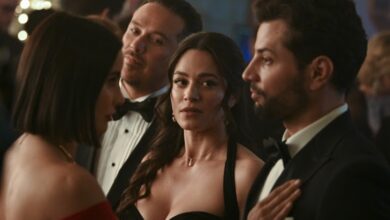
[ad_1]
Foreword Disclaimer From An Old Gamer
Season Two of Halo was not what I was expecting. Going into this series, I’ve made a decision of being open-minded to the possibilities this show can offer, disregarding my overly aggressive bias on the Halo franchise, not as a television series but as a multi-awarded gaming franchise that has placed itself as one of the greatest games of all time. That is coming from a guy who only played on a Playstation and not an Xbox.
Being a gamer myself, my earliest recollection of being introduced to its world was playing the first Halo game in the early 2000s. I didn’t own an Xbox and I’ve also been hearing good things about it, prompting me to buy a PC version of it(Which was really fortunate because my laptop back then was junk yet it was adequate enough that I can play the whole game through, so kudos to Bungie for making it like that).
I’ve gone through decades playing first-person shooters starting with Wolfenstein, then Doom, and even played Heretic at some point. Older generations will look at the 90s as the Golden Age of FPS with the likes of Counter-Strike, Golden Eye, and Half Life. (Full disclosure, me and my classmates were playing Heretic II on LAN while attending computer class and the teacher never noticed.) I even got to watch Quake tournaments on a cable show before, which is a fun yet weird way to get familiarized with capture the flag team tactics. Sufficing to say, the FPS genre is constantly evolving and being introduced to Halo’s world was definitely a memorable experience, for me and my 256mb RAM Laptop.
After watching Season 2 of Halo, I was wondering why the show is getting so much hate. And not just any haters of the genre but real, passionate gamers hating on this show with so much vitriol that even I was hesitant to watch it. Before going in-depth with the second season of Halo, I just want to address the big, fat elephant in the room, which is Master Chief.
To Helmet, or Not To Helmet. That Is The Question
All the gaming puritans out there thinking that the show is an insult to their beloved franchise are well within their right to say as such. Fanboys that continue to relentlessly assault the show as it does not depict the essence of the Halo Universe is partly correct. As part of that community I can honestly ask this question to the show-runners with empathy and loyalty to the franchise. “How dare you! How dare you make changes to our beloved Master Chief!”
There is a huge difference in watching a game and playing it. For each person who played the Halo games, they have a core memory of what is good and what is bad about it. And each memory may differ from person to person, but if the collective agrees on specific good memories, that is what’s known as a good review for the game.
Now here comes the hard part and the quintessential problem the gaming community has with Halo and Master Chief as a character. You can hear their collective lungs give out as they shout these words. “He’s not wearing his helmet! Why does he keep removing his helmet?!” The Helmet argument is really the primary problem with viewers who have played the game.
We didn’t care what Master Chief looked like underneath, and we demanded that that should remain in the TV show. That Master Chief ‘always’ wears his helmet, no excuses. After the initial trailer for Halo season one, I could see a faint visual projection of The Godfather’s Vito Corleone crying over his son’s body uttering, “Look how they massacred my boy.”
This can be argued with the prominence of The Mandalorian. Yes, I’m going there. As that series played out its episodes, it was in the last episode we got to see Mando take off his helmet for a good reason. We got to see action, drama, and even a bit of comedy as the main character never deviated from The Way and always had his helmet on. So if The Mandalorian can do that, why not Halo? With that ominous question, I would like to answer with this: Iron Man 3.
Beneath This Mask, There Is An Idea
The statement above is one of the famous lines in Alan Moore’s V for Vendetta. In comparison to The Mandalorian argument, I believe that the show runners have trekked the Iron Man 3 route. To give some well-needed background, Iron Man 3 focused on Tony Stark’s heroic endeavor without the use of his mechanized suit for majority of the movie’s run time. This gives legitimacy to Stark’s prowess as a scientific and engineering genius. That the suit does not make the man. Throwing in a quick Kingsman anecdote, Manners Maketh Man.
Master Chief as a titular character needed to be more than just the armor, more than just the helmet. In contrast to The Mandalorian character, Master Chief is an integral part of humanity’s fight against the Covenant. That beneath the armor there is an idea. The Master Chief armor is a symbol reflecting humanity’s tenacity to fight its oppressors. Though the armor is just a symbol, the Spartan wearing it represents humanity’s very essence: broken, manipulated, and abused.
Master Chief, or John-117 as he is known, gives contrast to the rose-tinted glasses everyone wanted to see in him, giving him titles such as the hero of humanity or humanity’s last hope. Being able to carry that title is a cumbersome weight to be put in one man.
Let me repeat that. One man carries the symbolic weight of humanity’s fight for survival. Mando was a wandering bounty hunter and had an arm’s length worth of responsibilities compared to Master Chief. With such a burden, we needed to see the man beneath the armor even if we thought we didn’t need to. And I think that season two of Halo gives legitimacy to that argument as I give my review of the series. With that in mind, let’s get to the show.
Halo Season Two: Better Than Expected
After watching the show, I have to admit that it was a really good sci-fi show. Watching this show without any preconceived thought about the game’s narrative history made it a lot better to enjoy the show as it is. If you’re still with me after all my superfluous explanations, I tip my hat to you and will reward you with season 2’s narrative.
The events leading up to season two where Cortana is removed from Master Chief, Catherine Halsey is missing, and a new player emerging from ONI in the form of James Ackerson, make it seem like the search for the Halo will finally step up a notch. Six months after the events of the first season, Master Chief and the Silver Team are tasked with babysitting missions until Master Chief encountered a peculiar group of Covenant operatives just before ‘glassing’ an entire planet.
As tension grows, Master Chief’s actions casts doubt even to his own team. With the devious machinations of Admiral Parangoskyand Askerson, most of the team are stripped of their armors and kept out of the loop as the Covenant began their attack, leading up to the fall of Reach led by the Arbiter and Makee.
Cortana also makes her return, being used by ONI to make strategic calculations against the Covenant. Her vast knowledge in human technology had also made her a viable target for the Arbiter, stealing her from ONI once the Covenant had accessed Reach.
With the fall of Reach, Master Chief is forced to team up with Halsey, Soren, and Kwan to discover Admiral Parangosky’s plan to wipe out the Covenant and get himself to the Halo. The series ends with Master Chief entering an artifact building inside the Halo after defeating the Arbiter.
Looking Back, Halo Was Good
Apart from the very distinctive set designs and costumes laid out for each character, the world is truly immersive, though there were sometimes semi-passable CGI battles and sequences, it can be tolerated in minimum doses. The thematic music and effects were better than expected, as well as portrayals of key characters, which I’ll be going through in detail.
Pablo Schreiber plays Master Chief like a second skin. Though there isn’t much depth needed for a militaristic protagonist always bent on doing the right thing, his acting beyond the use of his armor gives weight to how vulnerable his character can be, as well as showing the tenacity in the human spirit to endure anything that come its way. Schreiber didn’t need to act his heart out for every scene, he did his purpose, which was to show the audience that the man behind the mask can be more than just a token heroic character without flaws.
Surprisingly, I was astonished at how good Bokeem Woodbine could be when given just enough material to make an anti-hero likable. Playing as the Spartan-turned-Pirate Soren-066, Bokeem was funny, entertaining, and also menacing when situated in a high-staked showdown. I found his character, along with Fiona O’Shaugnessy’s Laera, had great dynamic and even stealing the scenes from other noteworthy characters around them.
Sub-Par Antagonists
Now, for the second season of Halo, there were three levels of antagonists, and all three differ in their narrative as to be Master Chief’s hurdle to overcome.
The first one comes in the form of Ackerson, the replacement for Halsey and the one giving orders to the Spartans. From the very start, Ackerson was out to get the Master Chief and meddle his way into our hero’s crosshairs. Ackerson, played by Joseph Morgan, was an annoying yet terrific addition to the whole ONI narrative for Halo. Morgan did a great service in portraying your typical corporate executive using the military to further his goals.
The second one is attributed to the Covenant Elite called the Arbiter. With the help of Makee, they try to give weight to their deluded prophecy as they navigate the planets in search of the Halo. The Arbiter is a pretty straight forward bad guy from beginning to end, always looking for dignity in a battle and fulfilling his goal in a timely manner and place.
Lastly, and most probably the weakest antagonist of the group is Admiral Parangosky, played by Shabana Azmi, and her egotistical manner in which she manipulates our hero and abuses her power to win the war against humanity’s enemies. Initially seen as a guide and ally of our hero, the Admiral suddenly became the one pulling the strings instead of Ackerson, shifting the blame towards her for the fall of Reach.
Just an extra note, though Dr. Catherine Halsey, played by Natascha McElhone, is neither on the side of the protagonist and antagonist, she single-handedly introduced a deadly virus that captivated the entire base along with herself at the very end of the season finale. So, there’s that. I don’t really know what they were going for there, but I’m pretty sure the Alien franchise already did that whole thing.
Final Thoughts on Halo Season 2
I’ve given this series a chance and it definitely paid off. The story was well-paced and the side characters made fluffing the narrative bearable most of the time. The action is well directed as well as the large-scale battle scenes primarily in the fall of Reach. Halo was actually a good sci-fi action show, and I would recommend it for those with enough courage to leave their bias at the door and give it a chance. After ending the series with the discovery of the Halo, I can’t wait to see what’s in store for Master Chief.
Source link










